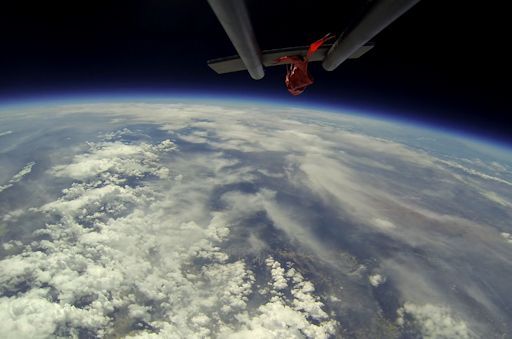Listen to radar echoes from satellites and meteors, live on listener-supported Space Weather Radio. | | |
VERY QUIET SUN: The face of the sun is nearly blank. There are only two tiny sunspots and neither one is flaring. NOAA forecasters estimate no more than a 1% chance of M- or X-class flares during the next 24 hours. Solar flare alerts: text, voice.
IN CASE YOU MISSED IT: Last night, sky watchers in Europe and the Americas witnessed a beautiful conjunction of Venus and the crescent Moon. At closest approach, the two brightest objects in the night sky were less than 1o apart. Vincent Gulizio sends this picture of the gathering from Brooklyn, NY:

"We had great conditions for tonight's Moon-Venus show--the air was crisp, and skies were clear," says Gulizio. "I managed to get a great spot as the Moon and Venus were setting next to the Verrazano Narrows Bridge. Spectacular is all I have to say!"
In case you missed it, a similar conjunction will next place next month on Oct. 7-8. (Mark your calendar.) Meanwhile, check the gallery for more images of last night's display.
Realtime Space Weather Photo Gallery
RIM FIRE FROM THE EDGE OF SPACE: The Rim Fire overlapping Yosemite National Park has now burned more than a quarter of a million acres (390 sq. miles), and according to the US Forest Service it may continue to grow, thanks to low humidity and other conditions. Smoke from the wildfire is affecting an even greater area. On Sept. 1st, the students of Earth to Sky Calculus sent a camera to the edge of space for a wide-angle shot of the smokey plumes:

This photo, which was taken from the payload of a helium balloon 110,000 feet above Earth's surface, captures more than 10,000 sq. miles of terrain. About half is covered with filaments of smoke from the Rim Fire. There is far more smoke in the image than cumulus clouds. In recent weeks, shifting wind patterns have drawn the plumes back and forth across the mountain towns of the eastern Sierra Nevada, prompting frequent air quality warnings in some places. This photo shows that helium balloons can be effective tools for monitoring the location of the smoke.
The black bars and popped red balloon jutting into the top of the photo are part of another ongoing experiment. The students have been dispersing small amounts of powder and ash into the stratosphere to measure the "hang time" of tiny particles. The particles ascend inside a small balloon, which pops at altitude to scatter its contents at the edge of space. As NASA studies of an exploding asteroid over Russia have confirmed, fine ash deposited in the stratosphere does not immediately fall to the ground. It circles the globe for months or more, usually landing harmlessly in remote ocean areas.
More information about the group's edge of space experiments may be found on Facebook.
Realtime Space Weather Photo Gallery
Realtime Aurora Photo Gallery
Realtime Noctilucent Cloud Photo Gallery
[previous years: 2003, 2004, 2005, 2006, 2007, 2008, 2009, 2011]
Realtime Comet Photo Gallery

